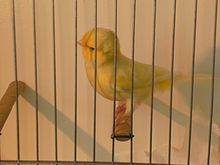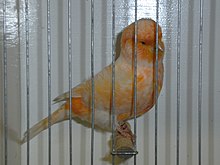Australian plainhead

The Australian plainhead is a breed of domestic canary that was created for show purposes. The variety was developed through selective breeding and remains the only breed of canary created in Australia.
History
[edit]The Australian plainhead has its roots in the old style Norwich canaries that originated in Norwich, England and became a popular show variety in Australia.[1] In the 1930s, differences between the older show standard used by the breeders of Victoria, Australia and the more modern standards of the UK, created a bitter divide amongst Australian breeders of the Norwich canary.[2] Decades later, after the modern Norwich had largely displaced the old-style birds from the Victorian show scene, a club was started in 1953 to preserve the old breed which was renamed the Australian plainhead.[2] By 1991, the number of Australian plainhead canaries in Australia had dropped to around 460 birds.[3] Whilst the Australian plainhead remains a rare breed, it is now far more widespread with birds being bred throughout Australia and in the US.[3]
Showing
[edit]
The Australian plainhead is a "type canary", which is mainly judged for its shape (referred to as type). Despite this, the breed is also noted for its colour and feather quality.[4] Australian plainhead may be green, blue (grey), yellow, white, cinnamon, fawn and variegated. Show birds may be "colour-fed" carotenoids during molting which gives new feathers an orange hue, but this is optional.[5] The birds are shown in a box style show cage with a white interior.[5]
Breeding
[edit]Australian plainheads typically breed well with basic care and attention.[2] While many other large canary breeds require foster pairs to rear their offspring, Australian plainheads are good feeders and usually rear their own young.[2]
See also
[edit]- Atlantic canary (wild canary)
- Domestic canary
- Harz Roller, another breed
- Red factor canary, another breed
References
[edit]- ^ Passignani, Giuliono; Giordana, Nicola; Barra, Ugo (2007). Il mondo dei Canarini di Forma e Posizione Lisci. Federazione Ornicoltori Italiani: Tipolitografia Editrice Lumini. pp. 195–198.
- ^ a b c d Williams, Frank (2000). The Australian Plainhead Canary. J. Leaney & F. Williams. pp. 5–9, 20. ISBN 0 9585336 6 0.
- ^ a b Leaney, Jeff (November 2005). "Plain, but attractive". Talking Birds: 7.
- ^ Bracegirdle, Joe (1986). Exhibition canaries. England: Triplegate Ltd. pp. 133–134. ISBN 086230 054 1.
- ^ a b Leaney, Jeff; Williams, Frank (1993). The Australian canary handbook. Melbourne, Australia: Jeff Leaney & Frank Williams. pp. 47–48. ISBN 0 646 15338 2.
